#australaves
Text

The evolution of falcons is rather poorly understood. Thanks to genetic evidence we know that they're closely related to seriemas, parrots, and passerines, but their fossil record is patchy and little is known about the early members of their lineage.
But a group knows as masillaraptorids are giving us a rare glimpse at what some early falconiforms were up to. Known from the Eocene of Europe, these long-legged predatory birds seem to have been caracara-like terrestrial hunters specializing in chasing down prey on foot – although their wings and tails indicate they were also still strong fliers.
Danielsraptor phorusrhacoides lived during the early Eocene, about 55 million years ago, in what is now eastern England. Although only known from partial remains, it was probably around 45-60cm long (~1'6"-2'), and it had a large hooked beak with a surprising amount of convergent similarity to those of the flightless South American terror birds.
Its mixture of falcon-like and seriema-like features may indicate that the common ancestor of both of these bird groups was a similar sort of leggy ground-hunting predator.
———
NixIllustration.com | Tumblr | Twitter | Patreon
#science illustration#paleontology#paleoart#palaeoblr#danielsraptor#masillaraptoridae#falconiformes#australaves#bird#dinosaur#art
760 notes
·
View notes
Text
Fossil Novembirb 9: Getting a Grip

Zygodactylus by @thewoodparable
Today, half of all birds - so half of all living dinosaurs - are in a clade called Passeriformes, aka "Perching Birds". Of course, not all birds that perch are in this clade, but what can you do. With three toes forward and one long toe facing back, these animals can easily perch upright on branches and have tendons in their legs to help stiffen their grip while sleeping, enabling them to stay put!
But where did this giant group get started?
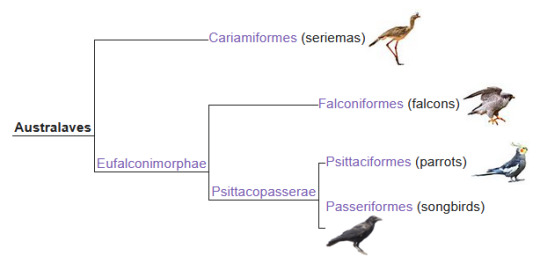
Australaves phylogenetic tree from Wikipedia
For a while, the prevalent idea was that they evolved from similar birds that perch in trees, such as pigeons and swifts. However, genetic evidence showed that the closest relatives of passerines were actually... parrots! And their closest relatives are Falcons, and just outside of that, Seriemas! What a wild twist!
Of course, paleontologists - being paleontologists - wanted to find the fossil evidence of this evolution. Luckily, as the genetic picture became clear, so did the fossil one - a handful of fossil birds that were mysteries before suddenly became clear, and more and more are being found as time goes on.
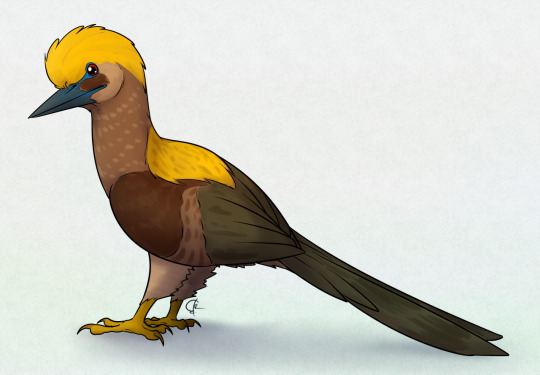
Primozygodactylus by @quetzalpali-art
In the Early Eocene, many of these early Passerine-Parrot relatives existed, and showcase a fascinating stepwise evolution of Passerine characteristics - namely, the feet. While the smaller head and size of Passerines evolved first, and show up in early relatives such as Zygodactylus, the foot arangement? Not so much. Instead, these animals had the bodies of passerines, and the feet of parrots! This indicates that the skinny legs and specialized wing shape of Passerines evolved first, and the special feet second. Truly, this and the many other stem-passerines we have found with this configuration qualify as "Evolutionary Missing Links". Dinosaurs remain our best way to show how evolution has happened over time! But I digress.
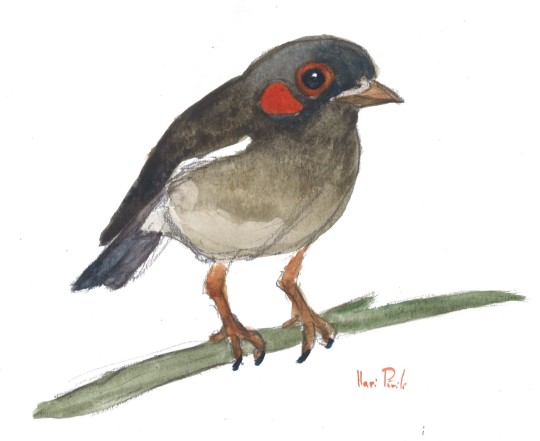
Eofringillirostrum by @otussketching
From these animals eventually came Passerines, though they were not especially common to begin with - many other birds lived in trees too, such as Mousebirds, and like all great dynasties, Passerines needed time to get started. That doesn't mean they weren't around - Eofringillirostrum, one of the smallest fossil dinosaurs we have, was already living kind of like a modern finch, without being closely related to them!
What's weird, however, is that most of our earliest known passerine and stem-passerine fossils are from North America and Europe. This is, however, a sampling bias - we just have spent more time looking for fossils in these locations. The "most basal" (ie, earliest-branching) passerines and parrots are both found in Aotearoa today - indicating that this clade probably diverged and first appeared somewhere in Oceania. Hopefully, fossils of these early Passerine-Parrots will be found in the region soon!
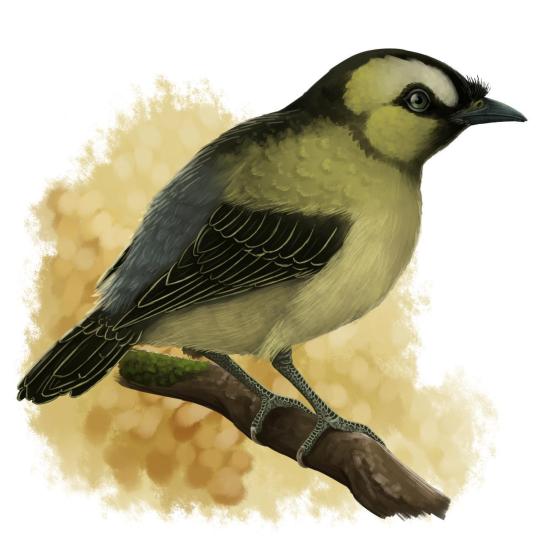
Wieslochia by @drawingwithdinosaurs
Alas, Passerine fossils of any kind do not become particularly common until the early Miocene, indicating that the climate change occurring globally at the time did allow Passerines to diversify more than they had previously. Perhaps Passerines were more adaptable to colder and drier climates than other tree birds had been, or their specialized perching feet allowed them to live easier in different types of forests. By the late Miocene, modern genera were even appearing. Though these delicately boned dinosaurs do not fossilize easily, more and more of the puzzle is showcasing how we got to the point where half of all living dinosaurs belong to this group.
In fact, thanks to genomics, we have something of an idea as to why Passerines speciate at the drop of a hat - and that reason is recombination! For some reason, Passeriformes are more prone to genomic restructuring and shuffling, with even short periods of separation between populations leading to rapid accumulation of these genomic architectural differences. Between that and the variety of ecologies such small arboreal animals can inhabit, it was just a perfect set of conditions for so many species to evolve - and honestly? I doubt Passeriformes are going anywhere any time soon.
Sources:
Conway, M., B. J. Olsen. 2019. Contrasting drivers of diversification rates on islands and continents across three passerine families. Proceedings of the Royal Society B 286(1915): 20191757.
Gibb, G. C., R. England, G. Hartig, P. A. McLenachan, B. L. Taylor Smith, B. J. McComish, A. Cooper, D. Penny. 2015. New Zealand Passerines Help Clarify the Diversification of Major Songbird Lineages during the Oligocene. Genome Biology and Evolution 7(11): 2983-2995.
Manthey, J. D., J. Klicka, G. M. Spellman. 2021. The Genomic Signature of Allopatric Speciation in a Songbird is Shaped by Genome Architecture (Aves: Certhia americana). Genome Biology and Evolution 13(8): evab120.
Mayr, G., A. C. Kitchener. 2022. Psittacopedids and zygodactylids: the diverse and species-rich Psittacopasserine birds from the early Eocen London Clay of Walton-on-the-Naze (Essex, UK). Historical Biology 35 (12): 2372-2395.
Mayr, 2022. Paleogene Fossil Birds, 2nd Edition. Springer Cham.
Mayr, 2017. Avian Evolution: The Fossil Record of Birds and its Paleobiological Significance (TOPA Topics in Paleobiology). Wiley Blackwell.
Mayr, G. and A. Manegold. 2006. New specimens of the earliest European passeriform bird. Acta Palaeontologica Polonica 51(2):315-323.
139 notes
·
View notes
Text
Today’s bird is the Crested Caracara (sometimes referred to as the Mexican eagle)! Caracaras are what is known as a para falcon. This means that even though they are in the family Falconidae, they are classified differently from other falcons, or the true falcons, which are in Falconinae, while they fall into the subfamily Polyborinae or Caracarainae, or simply Caracara. With being classified in Falconidae, Caracaras (and all other falcons) are from a separate genetic line than other birds of prey, belonging to Australaves, which is a clade that also includes parrots and songbirds, meaning that falcons are more closely related to parrots than to other birds of prey.
Beyond the genetic lines and classifications, the caracara is all the more confusing with its behavior. Behaviorally, they are far more similar to vultures than falcons: they’re gregarious (social), they’re extremely intelligent (there’s a link between social birds and intelligence), they’re fairly terrestrial (on the ground most of the time, only flying when necessary), and they will scavenge. This also adds to competition that vultures face for carrion, caracaras will follow turkey vultures, as will bald eagles and black vultures, to try and find carrion as the turkey vulture has a far superior sense of smell to all the birds mentioned. Caracaras will also eat eggs, and they’re fairly strong generalist hunters alike the barred owl, as mentioned yesterday. They’ll hunt amphibians, reptiles, and small mammals.
In my opinion one of the coolest things about the crested caracara is that their cere (fleshy upper beak) acts essentially like a mood ring, changing almost instantaneously from a red-orange color to a shade of yellow if excited. These birds are just so amazing to watch, and I’m lucky to be able to interact with one on a regular basis (she likes me!!)
(oh, and they have the most stunning eyelashes in the bird world only rivaled by the secretarybird)
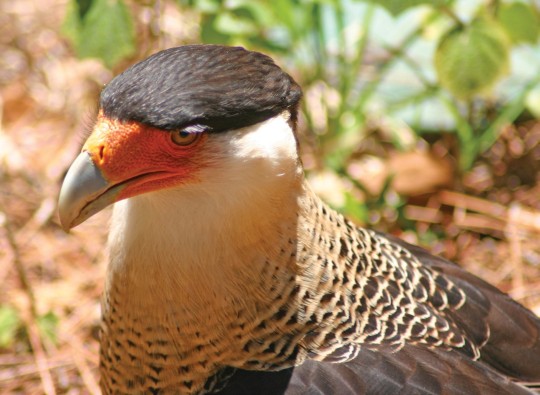
2 notes
·
View notes
Note
My impression was Neoaves was pretty settled now but passeriformes in particular are still a mess
(context: bird hell)
I'd believe that! All I know is from Wikipedia, which does not seem to want to pick a side yet.
Not that any other taxonomy website seems to have picked a side, either. The IOC's taxonomy has Neoaves, Aequornithes, Telluraves, and Australaves, but nothing I'd think of as particularly controversial.
0 notes
Text
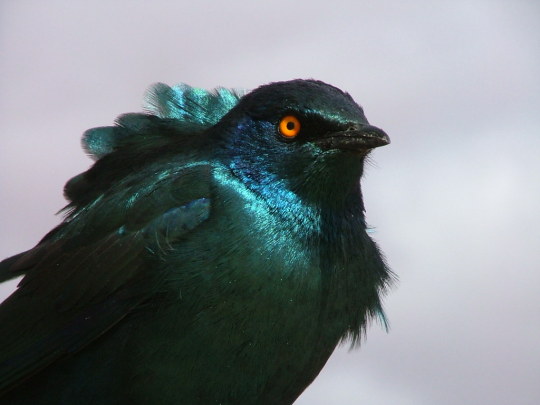
Burchell's starling (Lamprotornis australis)
Photo by GEO M I
#burchell's starling#lamprotornis australis#lamprotornis#sturnidae#muscicapoidea#muscicapida#passerides#passeriformes#psittacopasserae#eufalconimorphae#australaves#telluraves#inopinaves#neoaves#neognathae#aves#therapoda#archosauria#sauropsida#reptilia#tetrapoda#vertebrata#chordata
212 notes
·
View notes
Note
My understanding of phylogenetics is definitely limited so maybe I'm the one who's been getting it wrong this entire time, but if you haven't done so already would you mind explaining the studies about falcons being part of the Australaves clade? I find a lot of people saying things like "falcons are closely related to parrots" which I feel is a bit misleading, but again I could be wrong. Thanks in advance!
Sure! Australaves is the name given to a clade containing the seriemas, falcons, parrots, and passeriform birds. This group was first discovered by genetic analyses in the mid-2000s. As one might expect, this was a very unexpected finding, because prior to this no one had considered that all of these birds might be closely related to each other. (For example, seriemas were traditionally thought to be more closely related to cranes, falcons were thought to be more closely related to hawks, passeriforms were thought to be more closely related to woodpeckers, and so on.)
However, many more genetic studies on birds have been done since then by different research teams sampling different types of genes, vastly greater amounts of genetic data, and larger numbers of bird species, and Australaves has been consistently supported by nearly all of these. We can be pretty confident at this point that Australaves is a real clade.
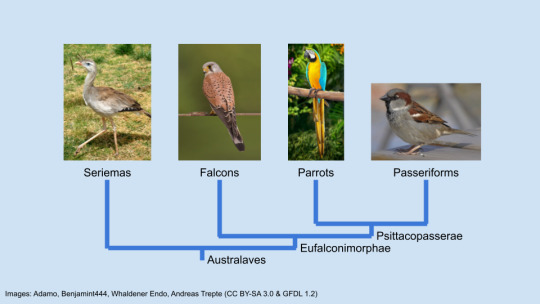
Within Australaves, parrots and passeriforms are each other’s closest living relatives, and falcons are most closely related to the clade uniting both of them (which has been given the long name of Psittacopasserae). So it would not be incorrect to say that falcons are closely related to parrots, because parrots are indeed among the closest living relatives that falcons have.
However, I’ve occasionally seen people claim that parrots alone are the closest living relatives of falcons, and that is not correct. Instead, parrots and passeriforms are together the closest living relatives of falcons, and falcons are equally closely related to both (much like how a pair of siblings is equally closely related to their first cousin, instead of the cousin being more closely related to one sibling than to the other). The group containing falcons, parrots, and passeriforms (but not seriemas) has another mouthful of a name, Eufalconimorphae!
114 notes
·
View notes
Note
bird [Splice]
Turn my Muse into a Splice!
Australaves branch (Include: passerines, parrots, falcons, Cariamiformes (including seriemas and the extinct “terror birds”)
Powers: Avian Physiology, Ziz Physiology (Feral Mind, Shadow Generation, Blizzard Creation), Raptor Physiology (Predator Instinct), Telescopic Vision, Enhanced Bite, Decelerated Aging, Parrot Physiology (Voice Manipulation), Corvid Physiology (Beak Generation), Prey Instinct, High-Speed Flight, Impale, Omnitone,
Appearance: Normal looking for the most part, has slightly diamond shaped pupils, sharpened teeth, his hair pricks up more noticeably and is a little more thick than most others peoples are.
@acitypaintedred
Colden gave them a look, confused. Sure, he had been kidnapped, manipulated, mutilated, tortured, driven mad! Not having to grow up with his siblings because of all of those things. But he wouldn’t have thought he looked THAT much younger than his siblings. Being as they were triplets. Perhaps, in all his excitement he hadn’t noticed that they had, in fact, appeared, older than him. Colden gave a shrug “ Maybe they just, you know, got moldy because of all the money they’ve had at their disposal their entire life. Didn’t you know, drinking, smoking, and not rubbing your body in lotions to be soft, makes you moldy?” Colden had teased slightly before shaking his head. Then they brought up how his eyes had seemed creepy “ More like a cats? I really don’t get where this is going, or why you are bringing this up.” Colden lift a hand up then, nervously adjusting the glasses on his face “Haven’t you heard it’s not polite to point out these sort of things?”

#Asks#ColdenAsks#Skies#Remember that Colden was already Deaged a while back#KARMA REMEMBERS!#hehehe#Anonymous
0 notes
Photo
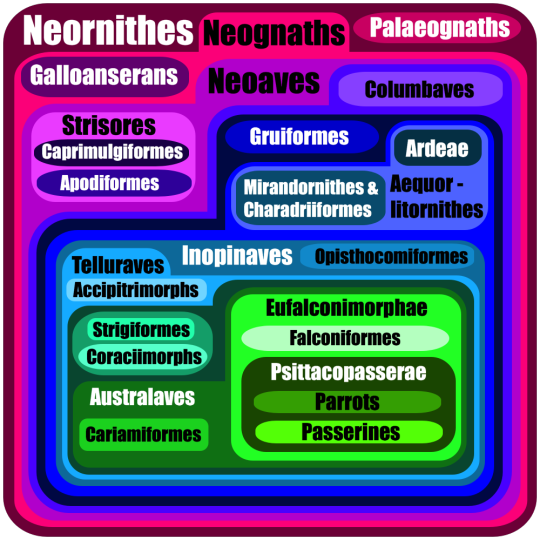
The most basic guide to Neornithes, aka Modern Birds
Everything is as simplified as possible. Based on Prum et al., 2015. Note some things:
1) All names here are of the groups used in Dinosaur March Madness (as a guide), and the relevant parent clades
2) According to Prum’s analysis, Camprimulgiformes are actually paraphyletic with regards to Apodiformes, i.e., Apodiformes should really be within Caprimulgiformes, but since this is a relatively controversial conclusion, I’ve left them separate for now
3) Aequorlitornithes is a ridiculously long clade name.
4) The classic clade of Afroaves was not, in fact, recovered; rather, Accipitrimorphs were found as being less closely related to Australaves than Strigiformes and Coraciimorphs were. Traditionally, Telluraves was divided directly in half: Afroaves (Accipitrimorphs, Strigiformes, and Coraciimorphs) and Australaves (Cariamiformes, Falconfiromes, Parrots and Passerines). Here, Accipitrimorphs falls outside of [Strigiformes + Coraciimorphs] + Australaves.
5) This doesn’t really take into account fossil taxa or morphological data.
6) Bird phylogeny is in flux. I doubtlessly will make more of these.
Source: Prum, R. O., J. S. Berv, A. Dornburg, D. J. Field, J. P. Townsend, E. M. Lemmon, A. R. Lemmon. 2015. A comprehensive phylogeny of birds (Aves) using targeted next-generation DNA sequencing. Nature 526: 569 - 573.
71 notes
·
View notes
Text
Fossil Novembirb 7: Ancient London Town

Halcyornis by @thewoodparable
Next on our excellent tour of Early Eocene Ecosystems is the London Clay Formation - an increasingly important location near yesterday's Fur that showcases another coastal forest of the post-PETM hothouse world. Filled with tons of fossil plants, London Clay is one of the world's most diverse localities for fossil seeds and fruits. Plus, it's lousy with dinosaurs! In fact, the first ever named fossil bird, Halcyornis, is from the London Clay!
Much like the Fur, there are just too many different kinds of birds in this ecosystem for me to talk about all of them - and more and more are being named lately, thanks to the donation of the late Michael Daniels' collection to researchers at last. There were strange ducks and owls, parrot-passerines of prey, paleognaths and loons, pseudotoothed birds and raptors, swifts and tubenoses and tropicbirds and more! Heck, even fossil cuckoo-rollers were present!

Nasidytes by @otussketching
In fact, the wide spread of many birds that today are limited to places in the southern hemisphere, such as Cuckoo-Rollers and Trogons, is a fascinating look into the radiation of Neoaves around the time of the PETM. Currently, the best hypothesis for this change is that these birds were adapted to the tropical temperatures, and when those climate bands retreated to their present positions these birds followed them. A prediction for the results of anthropogenic climate change? Who knows.
What's extra fascinating is that clearly, some birds didn't move, but just adapted to the cold - such as loons like Nasidytes above, as well as a variety of fowl and other birds. Why some birds went one way, and others another - and still others, towards extinction - remains a mystery.
But back in the Eocene, they were all hanging out together, apparently all over the place! That's what flight will get you, of course.

Dasornis by @quetzalpali-art
London Clay has a surprising amount of Pseudotoothed birds, which had been around since the Paleocene but did not become common until the Eocene. But here there were two different species - Dasornis and Odontopteryx - that were already well on their way to exploiting the marine soaring bird niche that most Pelagorns would one day inhabit.
Raptors were diversifying wildly here, too, with early relatives of falcons like Danielsraptor present and trying out a more terrestrial lifestyle than living falcons - perhaps an ancestral ecology for Australaves, given that Seriemas diverged before them! With a large curved beak and long legs, it was able to prowl the environment and hunt the scores of other birds living around it!
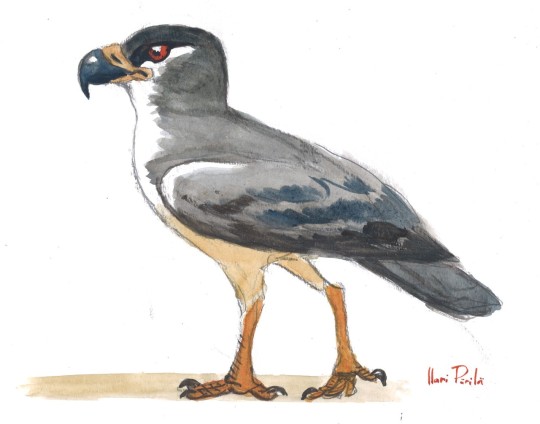
Danielsraptor by @otussketching
Lithornis was here, too, as it has been in the last two - a real staple of the PETM world, this Palaeognath was a strong flier, and was probably able to expand its territory successfully as the climate warmed around the world. The lack of Palaeognaths in North America and Europe today now seems even weirder by comparison! These birds would have used their long beaks to probe the sand and dirt for all the different sources of food hiding inside.
Early storm-petrels also showed up, alongside more tropicbirds, in the form of Primodroma and Prophaeton respectively, indicating that these kinds of shore birds not only evolved multiple times, but lived alongside each other in more of the world than they do today. Parrot-Passerines of prey, like Halcyornis and Pulchrapollia and Tynskya, were everywhere and filling the niche of tree dwelling raptors instead of things like falcons and hawks - amazing how much these dinosaurs have changed since!

Anatalavis by @quetzalpali-art
I would be remiss if I didn't bring up the ducks I helped to describe! Danielsavis was another hodgepodge duck-screamer, though less of it was preserved than Anachronornis. That said, it had a more screamer-like foot, shoulder, and jaw. With it lived Anatalavis, a bird possibly related to the living Magpie-Geese of Australia - wading birds with not much webbing and long goose-like necks. Anatalavis had a very duck-like beak, making it a filter-feeder, rather than a macrofeeder like the living Magpie-Goose. Eating on smaller animals and plants in the water, it didn't have any modern-type ducks around for competition!
Early owls were here too, like Ypresiglaux, a very small owl - weighing possibly less than 50 grams! This means that Ypresiglaux was the smallest known Owl of all history, and probably ate mostly arthropods. It also couldn't turn it's head around as much as living owls, and was possibly diurnal! Birds just kept diversifying into so many niches, it's amazing to see both the similarities and differences across so many clades.
Sources:
Collinson, M. 1983. Fossil plants of the London Clay. The Palaeontological Association 1: 1-122.
Mayr, 2022. Paleogene Fossil Birds, 2nd Edition. Springer Cham.
Mayr, 2017. Avian Evolution: The Fossil Record of Birds and its Paleobiological Significance (TOPA Topics in Paleobiology). Wiley Blackwell.
52 notes
·
View notes
Photo

Common raven (Corvus corax)
Photo by V.C. Wald
#id'ing#predation#common raven#corvus corax#corvus#corvinae#corvidae#corvoidea#passeriformes#eufalconimorphae#australaves#telluraves#inopinaves#neoaves#neognathae#aves#therapoda#archosauria#sauropsida#reptilia#tetrapoda#vertebrata#chordata
298 notes
·
View notes
Text
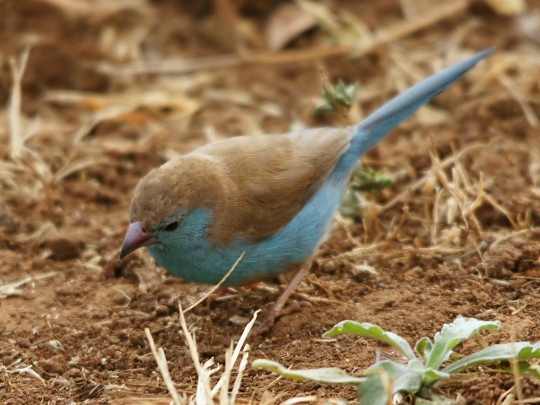
Blue waxbill (Uraeginthus angolensis)
Photo by Hans Hillewaert
#blue waxbill#uraeginthus angolensis#uraeginthus#amandavinae#estrildidae#passeroidea#passeriformes#psittacopasserae#eufalconimorphae#australaves#telluraves#inopinaves#neoaves#neognathae#aves#therapoda#archosauria#sauropsida#reptilia#tetrapoda#vertebrata#chordata
53 notes
·
View notes
Photo
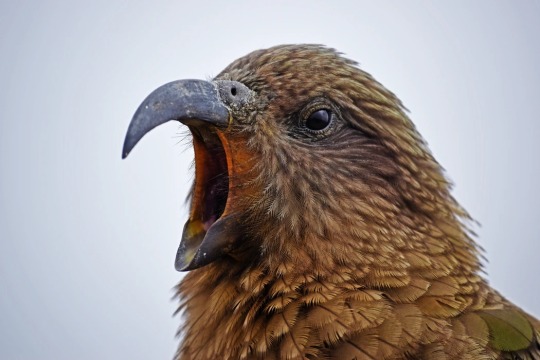
Kea (Nestor notabilis)
Photo by Karl Anderson
#kea#nestor notabilis#nestor#nestoridae#strigopoidea#psittaciformes#psittacopasserae#eufalconimorphae#australaves#telluraves#inopinaves#neoaves#neognathae#aves#theropoda#archosauria#sauropsida#reptilia#tetrapoda#vertebrata#chordata
240 notes
·
View notes
Photo

Nankeen kestrel (Falco cenchroides)
Photo by Victor Garland
#nankeen kestrel#falco cenchroides#falco#falconinae#falconidae#falconiformes#eufalconimorphae#australaves#telluraves#inopinaves#neoaves#neognathae#aves#theropoda#archosauria#sauropsida#reptilia#tetrapoda#vertebrata#chordata
204 notes
·
View notes
Photo
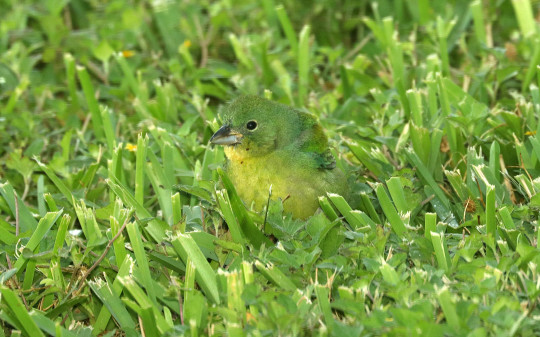
Painted bunting (Passerina ciris)
Photo by Alan Schimerer
#painted bunting#passerina ciris#passerina#cardinalidae#emberizoidea#passeroidea#passerida#passeriformes#psittacopasserae#eufalconimorphae#australaves#telluraves#inopinaves#neoaves#neognathae#therapoda#archosauria#sauropsida#reptilia#tetrapoda#vertebrata#chordata
52 notes
·
View notes
Text
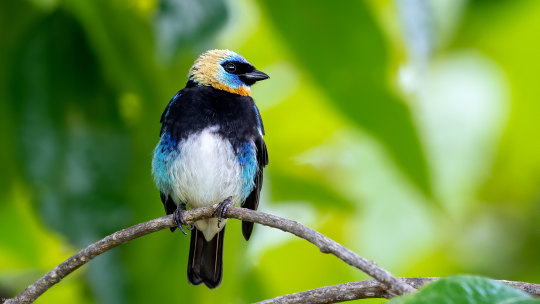
Golden-hooded tanager (Stilpnia larvata)
Photo by Mathurin Malby
#golden hooded tanager#stilpnia larvata#stilpnia#thraupinae#thraupidae#emberizoidea#passeroidea#passeriformes#eufalconimorphae#australaves#telluraves#inopinaves#neoaves#neognathae#aves#therapoda#archosauria#sauropsida#reptilia#tetrapoda#vertebrata#chordata
22 notes
·
View notes
Text
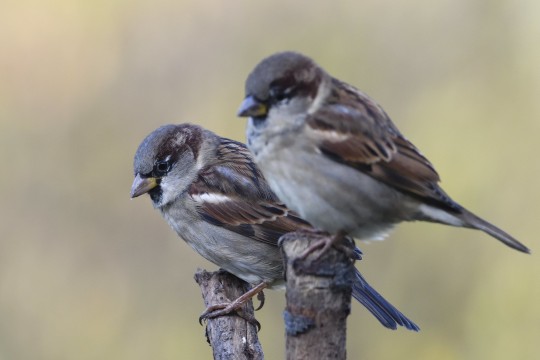
House sparrow (Passer domesticus)
Photo by Eric Courant
#house sparrow#passer domesticus#passer#passeridae#passeroidea#passeriformes#eufalconimorphae#australaves#telluraves#inopinaves#neoaves#neognathae#aves#therapoda#archosauria#sauropsida#reptilia#tetrapoda#vertebrata#chordata
13 notes
·
View notes